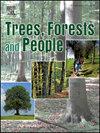Human disturbances and their impact on woody species diversity in sacred church forests in West Gojjam Zone, Northwestern Ethiopia
IF 2.7
Q1 FORESTRY
引用次数: 0
Abstract
Church forests are crucial refuges for biodiversity, yet human activities pose significant threats to their survival in Ethiopia. Therefore, a comprehensive understanding of woody species diversity and the effects of disturbances is necessary for effective conservation. This study aimed to investigate human disturbances and their effects on woody species diversity in 26 church forests in the West Gojjam Zone. Different types of human disturbances and vegetation data were collected from 26 church forests. To gather information on trees with a DBH ≥2.5 cm and height >2.5 m, 175 main plots measuring 20 m x 20 m (400 m2) were set up. Within the main plots, 875 subplots measuring 5 m x 5 m (25 m2) and 1 m x 1 m (1 m2) were placed to evaluate saplings and seedlings, respectively. Various types of human disturbances were recorded within these plots. Statistical analyses, including one-way ANOVA and linear regression, revealed considerable variations in woody species richness, with 111 species identified 1.8 % endemic, 15.32 % exotic, and 82.88 % indigenous. Key disturbances like graves, clearings, and grazing significantly impacted these forests. Larger forests and those at higher elevations experienced fewer disturbances, while lower elevation forests closer to population centers were more vulnerable. Edge effects exacerbated ecological challenges by promoting exotic species and altering species composition, leading to reduced biodiversity. Notably, significant changes in woody species abundance were observed across inner, middle, and edge plots. The study underscores the importance of community engagement, restoration projects, and ongoing monitoring to mitigate human disturbances, especially near forest edges, to preserve the ecological integrity of these vital church forests.
人为干扰及其对埃塞俄比亚西北部西Gojjam地区神圣教堂森林木本物种多样性的影响
教堂森林是生物多样性的重要避难所,但人类活动对其在埃塞俄比亚的生存构成了重大威胁。因此,全面了解木本物种多样性和干扰的影响是有效保护的必要条件。本研究旨在探讨人为干扰对西部Gojjam地区26个教堂林木本物种多样性的影响。收集了26个教堂林不同类型的人为干扰和植被数据。为了收集胸径≥2.5 cm、树高≥2.5 m的树木信息,设置了175个面积为20 m × 20 m (400 m2)的主样地。在主样地内,放置875个子样地,分别为5 m x 5 m (25 m2)和1 m x 1 m (1 m2),以评估树苗和幼苗。在这些地块内记录了各种类型的人为干扰。通过单因素方差分析和线性回归分析,结果表明,各树种的丰富度差异较大,共有111种,其中特有种占1.8%,外来种占15.32%,本土种占82.88%。墓地、空地和放牧等主要干扰因素对这些森林产生了重大影响。较大的森林和高海拔的森林受到的干扰较少,而靠近人口中心的低海拔森林则更容易受到干扰。边缘效应通过促进外来物种和改变物种组成加剧了生态挑战,导致生物多样性减少。值得注意的是,木本物种丰度在样地内部、中间和边缘均有显著变化。该研究强调了社区参与、修复项目和持续监测的重要性,以减少人类干扰,特别是在森林边缘,以保护这些重要的教堂森林的生态完整性。
本文章由计算机程序翻译,如有差异,请以英文原文为准。
求助全文
约1分钟内获得全文
求助全文
来源期刊

Trees, Forests and People
Economics, Econometrics and Finance-Economics, Econometrics and Finance (miscellaneous)
CiteScore
4.30
自引率
7.40%
发文量
172
审稿时长
56 days
 求助内容:
求助内容: 应助结果提醒方式:
应助结果提醒方式:


